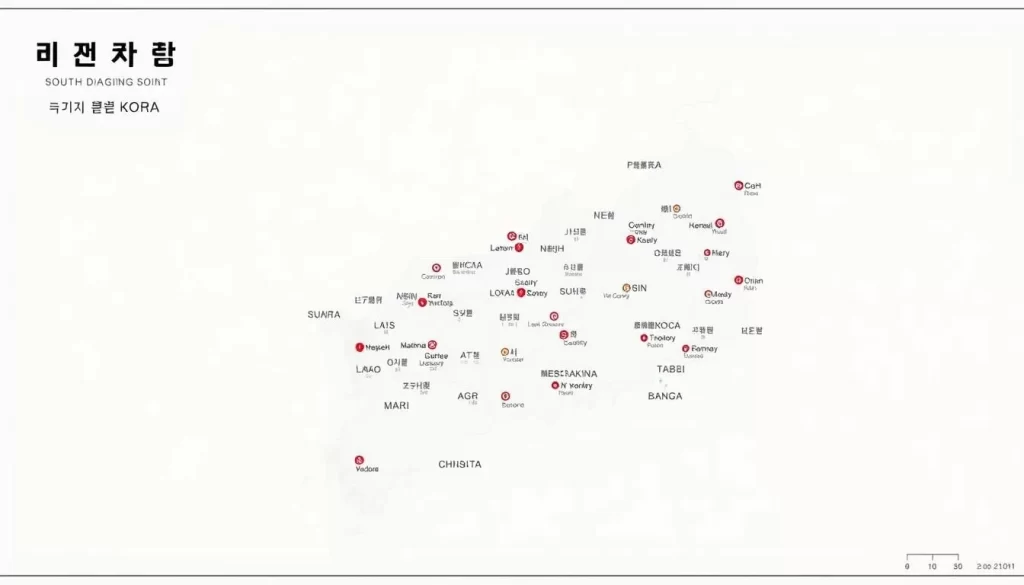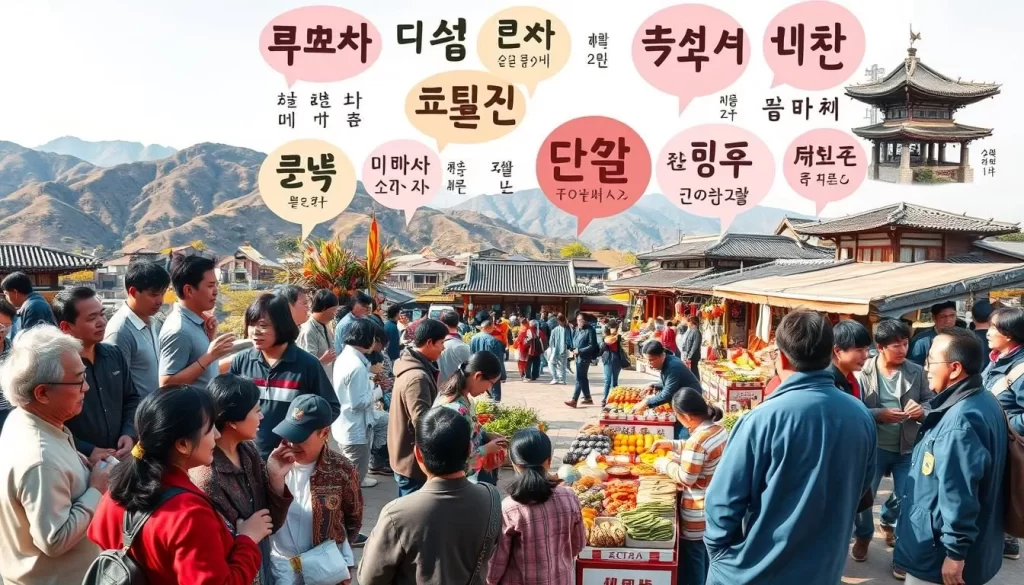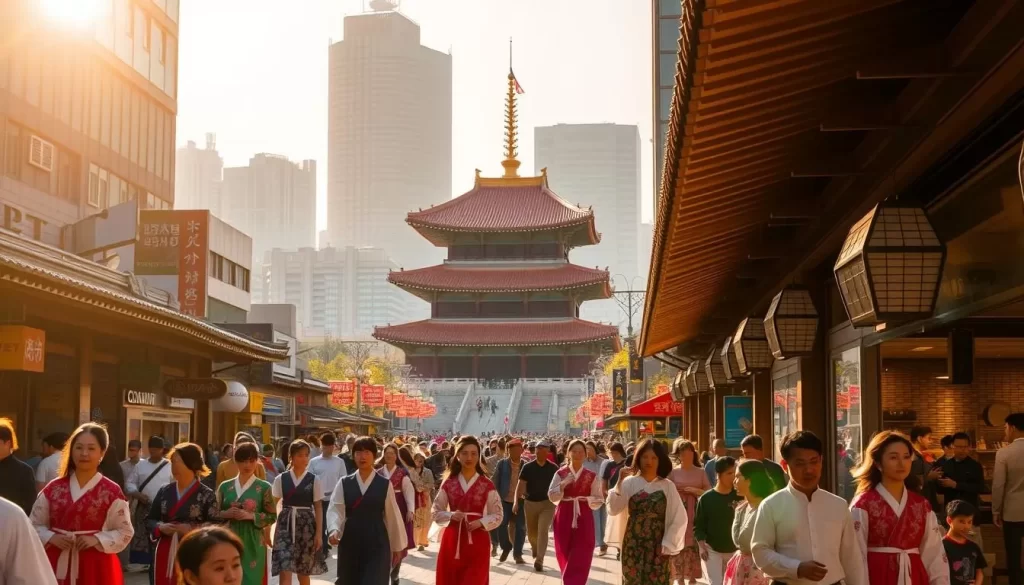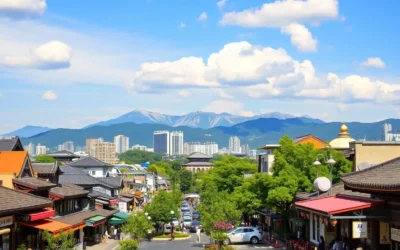✓ Accommodations ✓ Flights ✓ Rental Cars ✓ Tours & Activities
When you think of South Korea, its vibrant culture and rich history likely come to mind. At the heart of this fascinating nation lies its official language, Korean. This unique language is the only one spoken across the peninsula, with a standard dialect rooted in Seoul and the Gyeonggi Province.
Korean is more than just a means of communication; it’s a window into the country’s soul. Its grammar, vocabulary, and alphabet, known as Hangul, are distinct and deeply tied to its past. Over time, the language has evolved, shaped by historical events and modern influences, making it a living testament to the nation’s journey.
In this article, you’ll discover how regional dialects add diversity to the Korean language. From the melodic Jeolla dialect to the critically endangered Jeju dialect, each variation tells a story of its own. Understanding these nuances is key to fully appreciating the culture of South Korea.
Overview of South Korea’s Linguistic Diversity
Exploring the linguistic landscape of this country reveals a fascinating mix of unity and diversity. While one official language binds the nation, regional dialects add layers of complexity. These variations are not just accents but unique forms of expression tied to local cultures.
Over 97% of the population is connected to modern digital trends, with the standard dialect from Seoul dominating media and education. This creates a contrast between the language used in formal settings and the everyday language spoken by individuals. Understanding these differences is key to grasping the full picture.

Demographic statistics also play a role. High literacy rates and internet penetration mean that most persons are fluent in the standard dialect. However, regional vocabulary and expressions still thrive, especially in rural areas. These small variations shape how people communicate daily.
Key Statistics and Demographics
Here’s a quick look at some important data:
| Statistic | Value |
|---|---|
| Population using standard dialect | Over 90% |
| Literacy rate | 99% |
| Internet penetration | 97% |
| Regional dialects | 6 major groups |
These numbers highlight the balance between standardization and regional diversity. Whether you’re in a bustling city or a quiet village, the way people speak reflects their unique identity.
Historical Development of the Korean Language
The journey of the Korean language is a tale of innovation and cultural pride. Its history spans over 2,000 years, beginning with the use of Chinese characters for writing. This early system was complex and limited literacy to the elite, creating a barrier for common people.

Origins of Hangeul and Hunminjeongeum
In the 15th century, a revolutionary change occurred. King Sejong introduced Hangul, a phonetic alphabet designed to make writing accessible to all. This system, known as Hunminjeongeum, consisted of 24 letters and was easy to learn. It marked a turning point in Korean history, empowering ordinary citizens to read and write.
Before Hangul, about 10% of Korean nouns were borrowed from Classical Chinese. The new alphabet reduced reliance on Chinese characters, fostering a unique linguistic identity. This shift was a bold move by King Sejong, reflecting his vision for a literate and unified society.
Evolution Over the Centuries
Over the centuries, the Korean language continued to evolve. The Middle Korean period, from the 11th to the 16th century, laid the groundwork for modern Korean. By the 17th century, the language had transformed significantly, incorporating new vocabulary and expressions.
The 20th century brought further changes. The Korean War (1950-1953) led to linguistic divergence between the North and South. Despite these differences, the language remains mutually intelligible, a testament to its enduring unity.
| Period | Key Development |
|---|---|
| 57 BC – 10th Century | Use of Chinese characters |
| 15th Century | Creation of Hangul by King Sejong |
| 17th Century | Introduction of Modern Korean |
| 20th Century | Linguistic divergence post-Korean War |
These milestones highlight the resilience and adaptability of the Korean language. From its origins to its modern form, it continues to reflect the nation’s rich cultural heritage.
Regional Dialects and Their Unique Characteristics
From the bustling streets of Seoul to the serene landscapes of Jeju, dialects tell a story of regional identity. These variations are more than just accents; they reflect the history, culture, and geography of each area. Understanding these differences helps you appreciate the richness of the Korean language.

Seoul and Gyeonggi Province: Standard Korean
The Seoul dialect forms the foundation of Standard Korean, also known as Pyojuneo. This dialect is widely used in media, education, and formal settings. About 70% of its vocabulary is adopted as the standard, making it the most understood form of the language.
In Gyeonggi Province, the dialect closely resembles that of Seoul. However, younger generations are increasingly adopting the standard form due to media influence. This shift highlights the dynamic nature of language evolution.
Gangwon, Chungcheong, Jeolla, and Gyeongsang Dialects
Each region boasts its own unique dialect. The Gangwon dialect features vowel changes, such as ㅆ to ㅅ and ㅏ to ㅓ at the end of sentences. In Chungcheong, the tempo is slower, and verb conjugations often shift vowels, like ㅗ to ㅜ.
The Jeolla dialect is known for its melodic intonation and the use of filler words like 잉 (ing) for emphasis. Meanwhile, the Gyeongsang dialect stands out with its pitch accent and unique pronunciation, such as dropping the first vowel in compound words.
Jeju: A Distinct Dialect Identity
The Jeju dialect is so unique that some consider it a separate language. Recognized as critically endangered by UNESCO, it is primarily spoken by the older generation. Its grammar variations, like replacing ~요 with ~ㅂ서, set it apart from other dialects.
Despite its distinctiveness, mutual intelligibility among most dialects remains high. However, the Jeju dialect poses a challenge for those unfamiliar with its nuances.
| Region | Key Features |
|---|---|
| Seoul & Gyeonggi | Standard Korean, widely used in media |
| Gangwon | Vowel changes, ㅆ to ㅅ |
| Chungcheong | Slower tempo, vowel shifts in verbs |
| Jeolla | Melodic intonation, filler words |
| Gyeongsang | Pitch accent, unique pronunciation |
| Jeju | Critically endangered, distinct grammar |
Cultural and Social Influences on the Korean Language
Culture and media have shaped the way Koreans communicate every day. From ancient traditions to modern trends, these forces leave a lasting mark on the language. Understanding these influences helps you see how vocabulary and tone evolve over time.

Traditional Customs and Superstitions
Many traditions are deeply embedded in everyday speech. For example, the number four is avoided in some contexts because it sounds like the word for death. This superstition affects how people choose numbers for addresses, floors, or gifts.
Major holidays like Lunar New Year and Chuseok also shape language. These events emphasize family gatherings and culture, introducing specific terms and phrases into daily use. Such practices highlight the connection between language and societal norms.
K-pop, Dramas, and Global Cultural Impact
The global rise of K-pop and Korean dramas has introduced new terms and expressions. For instance, the phrase “Gangnam Style” became a worldwide phenomenon after PSY’s hit song. This influence extends to how younger generations speak, blending traditional and modern vocabulary.
K-pop groups like BTS have also popularized Korean words internationally. Their lyrics often include cultural references, making the language more accessible to global audiences. This trend shows how media can preserve tradition while introducing change.
| Influence | Impact on Language |
|---|---|
| Traditional Superstitions | Avoidance of the number four in vocabulary |
| Major Holidays | Introduction of specific terms and phrases |
| K-pop and Dramas | Global adoption of Korean words and expressions |
These cultural forces highlight the dynamic nature of the Korean language. Whether through tradition or modern media, the way people speak continues to evolve. By understanding these influences, you gain a deeper appreciation for the richness of Korean communication.
Official Language and Government Initiatives in South Korea
Government efforts play a crucial role in shaping how language is used and taught. In this context, the official language is a cornerstone of national identity and communication. The south korean government has implemented several initiatives to ensure its standardization and widespread use.
National Institute of Korean Language
The National Institute of Korean Language is at the forefront of these efforts. Established to manage and promote the official language, it oversees the development of language policies and standards. This includes the publication of the Standard Lexicon, which contains over 1.1 million entries.
By maintaining uniformity in vocabulary and grammar, the institute ensures that the language remains accessible and consistent across media and education systems. This systematic approach helps preserve the language’s integrity while adapting to modern needs.
TOPIK and Language Proficiency Standards
Another key initiative is the Test of Proficiency in Korean (TOPIK). This exam serves as a benchmark for language proficiency, benefiting both native speakers and learners. It plays a vital role in the education system, helping individuals demonstrate their language skills for academic or professional purposes.
The government’s focus on TOPIK reflects its commitment to fostering quality language education. By setting clear standards, it ensures that the language remains a vital part of the country’s cultural and economic fabric.
These initiatives highlight the importance of a structured system in preserving and modernizing the language. For more insights into how these policies shape the nation’s identity, explore this detailed analysis.
Comparing South and North Korean Language Variants
The Korean language has evolved distinct variants in North and South Korea due to decades of separation and differing linguistic policies. While both regions share a common linguistic origin, their paths have diverged significantly since the Korean War in the 1950s. This separation has led to unique developments in vocabulary, pronunciation, and even tone.
Mutual Intelligibility and Regional Accents
Despite the differences, the language variants remain mutually intelligible. Speakers from both regions can generally understand each other, though some nuances may require clarification. For example, the Seoul dialect forms the basis of the standard language in the South, while the Pyongyang dialect serves as the standard in the North.
Pronunciation differences are notable. In the North, the vowel “Lee” is pronounced as 리 (Ri), whereas in the South, it is 이 (I). These subtle variations can affect the overall listener experience, especially for those unfamiliar with both accents.
Differences in Foreign Loanwords and Vocabulary
Foreign influences have shaped the vocabulary in both regions differently. The South has incorporated many English loanwords, such as “myujikeol” for “musical,” while the North prefers Russian-influenced terms like “eumhakwi”. This divergence reflects the distinct cultural and political influences each region has experienced.
North Korean leaders discourage the use of borrowed words, resulting in a vocabulary that largely avoids English. In contrast, the South has embraced globalization, leading to a more diverse lexicon. For instance, the term for “lunch box” is “dosirak” in the South and “bapgwak” in the North.
“The Korean language, while unified in its core, reflects the unique identities of its two regions.”
| Aspect | South Korea | North Korea |
|---|---|---|
| Standard Dialect | Seoul | Pyongyang |
| Foreign Influence | English | Russian |
| Term for “Musical” | Myujikeol | Eumhakwi |
| Term for “Lunch Box” | Dosirak | Bapgwak |
These differences highlight how the language korean has adapted to regional contexts. For a deeper dive into these linguistic variations, explore this detailed analysis.
South Korea: Official and widely spoken languages
Understanding the nuances of Standard Korean (Pyojuneo) offers a window into the heart of Korean communication. This form of the Korean language serves as the foundation for education, media, and formal interactions. Rooted in the Gyeonggi region, it shapes how millions of people express themselves daily.
Standard Korean (Pyojuneo) Explained
Standard Korean, or Pyojuneo, is the benchmark for formal communication. It is used in schools, government offices, and media, ensuring consistency across the nation. This standard influences how the language is structured and written, making it accessible to all.
For example, the Gyeonggi dialect forms the basis of Pyojuneo, with about 70% of its vocabulary adopted as the standard. This uniformity helps maintain clarity in writing and speech, bridging regional differences.
Korean Sign Language and Digital Communication
As technology advances, Korean Sign Language (KSL) is gaining prominence. It plays a vital role in making digital platforms inclusive for the deaf and hard-of-hearing community. This evolution reflects the adaptability of the language system in modern times.
Digital communication trends are also reshaping everyday language. From social media to messaging apps, people are blending traditional and modern expressions. This shift highlights the dynamic nature of the Korean language in a connected world.
By exploring these elements, you gain a deeper appreciation for how language evolves. Whether through Standard Korean or digital innovations, communication remains at the core of Korean identity. For more insights, visit this detailed guide.
Impact of Globalization and Modern Media on Korean Communication
The digital age has revolutionized how we communicate, and Korean is no exception. Social media and mobile technologies have reshaped the way people form sentences and choose words in daily conversations. This evolution is particularly evident in the streamlined use of verbs and the adaptation of traditional language patterns to suit rapid digital communication.
Globalization has blurred traditional period-specific language boundaries. For example, the influx of foreign culture has introduced new vocabulary and expressions into everyday speech. This shift highlights how digital convergence is influencing both traditional and contemporary language patterns.
Social Media and Digital Trends in Language Use
Social media platforms like Instagram and Twitter have transformed the way Koreans communicate. Shorter sentences and concise word choices are now the norm, reflecting the fast-paced nature of online interactions. This trend is reshaping the structure of the language, making it more adaptable to modern needs.
Verbs, in particular, are evolving to fit this new communication style. For instance, the use of simplified verb forms has become common in digital conversations. This change reflects a broader shift towards efficiency and clarity in online communication.
Examples of this adaptation include the use of abbreviations and slang, which are now widely accepted in informal settings. These changes demonstrate how the language is evolving to meet the demands of a globalized, digital world.
For more insights into how globalization is shaping Korean communication, explore this detailed analysis.
Conclusion
The Korean language is a vibrant reflection of the culture and history of the peninsula. From its origins with King Sejong’s creation of Hangul to the modern use of Standard Korean, it has evolved while maintaining its unique identity. Regional dialects add richness, showcasing the diversity of each region.
Government initiatives and education systems play a key role in preserving this language. Programs like TOPIK ensure its accessibility and standardization. Despite differences between North and South, the shared linguistic roots highlight a common heritage.
Today, the Korean language continues to adapt, influenced by global media and digital communication. Its global reach, with over 77 million speakers, underscores its growing importance. To explore more about its global impact, visit this detailed guide.
The above is subject to change.
Check back often to TRAVEL.COM for the latest travel tips and deals.
Here are some Tours & Sightseeing suggestions that might pique your interests!






